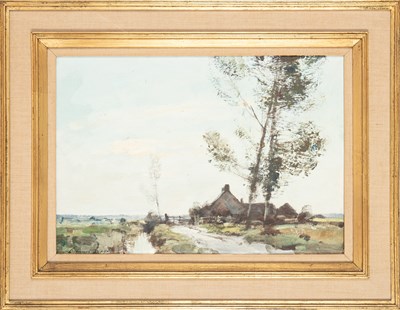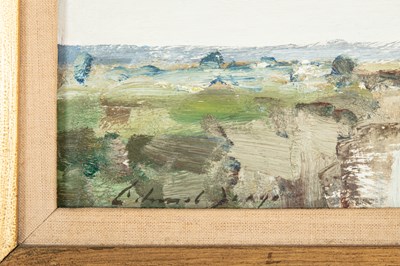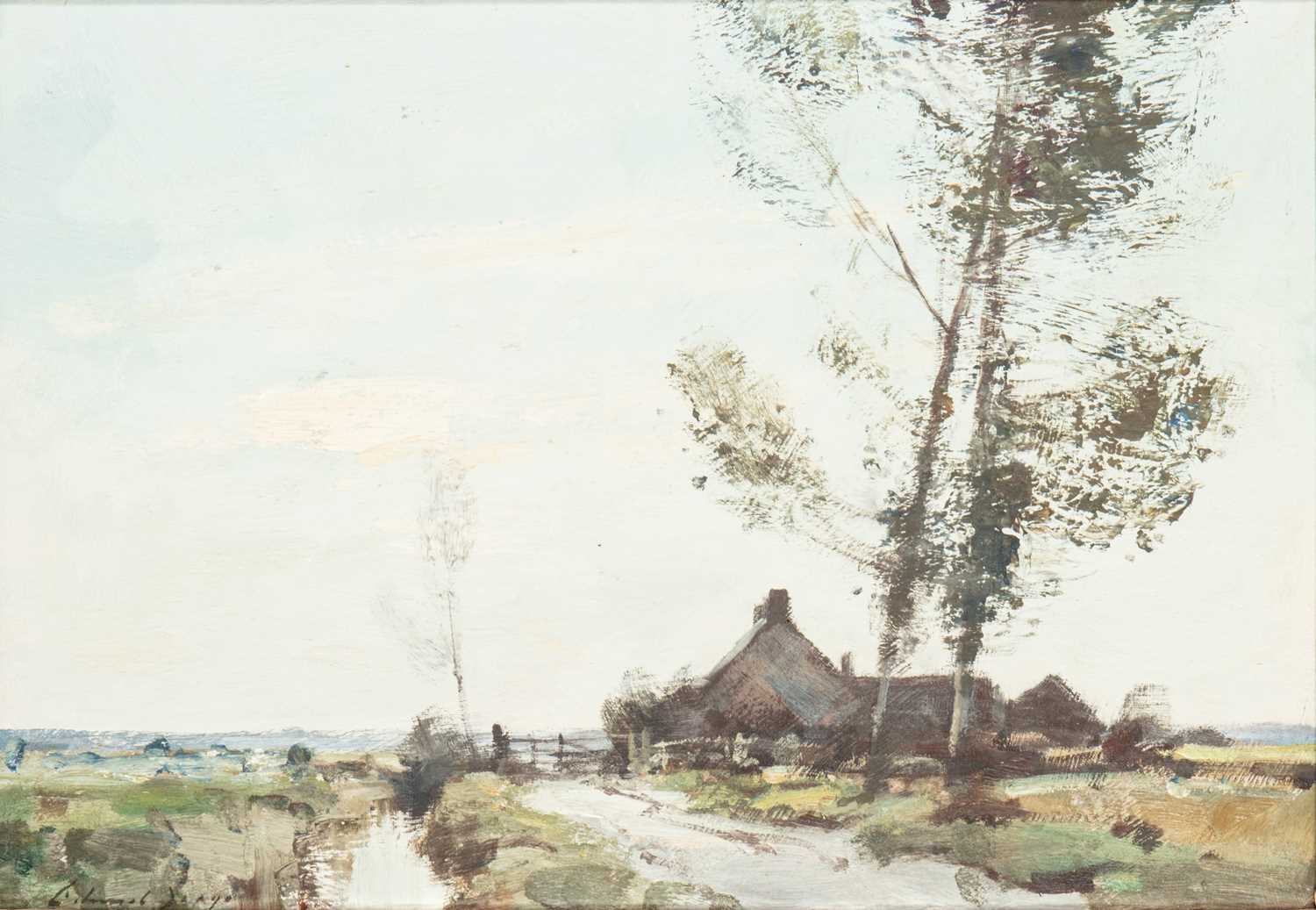13th Dec, 2023 12:00
Fine Paintings, Works on Paper & Sculpture
22
⊕ EDWARD SEAGO (BRITISH 1910-1974)
FARM NEAR SOMERTON - NORFOLK
signed Edward Seago lower left
oil on board
34 x 49cm; 13 1/2 x 19 1/4in
52.5 x 67.5cm; 20 3/4 x 26 1/2in (framed)
Property from a Private Collection
Painted in 1969.
Provenance
A gift to the grandmother of the present owner in the mid-1980s
Exhibited
London, Marlborough Fine Art, Edward Seago Memorial Exhibition, 1974-1975
London, Portland Gallery, Edward Seago Centenary Exhibition, 2010, no. 86
Painted near the Norfolk coast, Somerton lies some some thirteen miles east of Seago's home and studio in Ludham.
The son of a coal merchant, Seago was born and raised in Norfolk, where he painted local views as a boy when bedridden with a heart condition. After leaving school aged 14 he ran away to join Bevan's Travelling Show, touring widely with the troupe. He published the sketches and oils he completed of the performers and circus characters in Circus Company, Life on the Road in 1932. The introduction to the book was written by the poet laureate John Masefield, with whom Seago collaborated further, illustrating two volumes of Masefield's poetry: The Country Scene (1937) and Tribute to Ballet (1939). As well as Masefield, Seago acquired several other influential patrons during the 1930s. One was Henry Mond, 2nd Lord Melchet who invited Seago to Venice and commissioned him to paint a series of portraits of his family. Another was Princess Mary, Countess of Harewood, whose patronage brought his work to the attention of the Royal Family after the Second World War.
In 1946 Seago settled in Ludham on the Norfolk Broads, where he purchased the picturesque, seventeenth century Dutch House. There he focused on painting atmospheric views of the surrounding countryside, evoking the region's distinctive flat landscape and vast skies, punctuated by windmills, churches and marshland farmhouses. Queen Mary, Queen Elizabeth the Queen Mother, Prince Philip, The Duke of Edinburgh and Prince Charles, Prince of Wales at the time, all became devotees of his work, and his exhibitions with his dealer Colnaghi sold out immediately. Typically collectors queued around the block to acquire a painting, the gallery having to limit purchases to one each, a rule not dissimilar to those imposed by leading fashion brands today selling their merchandise to eager buyers on Bond Street.
FARM NEAR SOMERTON - NORFOLK
signed Edward Seago lower left
oil on board
34 x 49cm; 13 1/2 x 19 1/4in
52.5 x 67.5cm; 20 3/4 x 26 1/2in (framed)
Property from a Private Collection
Painted in 1969.
Provenance
A gift to the grandmother of the present owner in the mid-1980s
Exhibited
London, Marlborough Fine Art, Edward Seago Memorial Exhibition, 1974-1975
London, Portland Gallery, Edward Seago Centenary Exhibition, 2010, no. 86
Painted near the Norfolk coast, Somerton lies some some thirteen miles east of Seago's home and studio in Ludham.
The son of a coal merchant, Seago was born and raised in Norfolk, where he painted local views as a boy when bedridden with a heart condition. After leaving school aged 14 he ran away to join Bevan's Travelling Show, touring widely with the troupe. He published the sketches and oils he completed of the performers and circus characters in Circus Company, Life on the Road in 1932. The introduction to the book was written by the poet laureate John Masefield, with whom Seago collaborated further, illustrating two volumes of Masefield's poetry: The Country Scene (1937) and Tribute to Ballet (1939). As well as Masefield, Seago acquired several other influential patrons during the 1930s. One was Henry Mond, 2nd Lord Melchet who invited Seago to Venice and commissioned him to paint a series of portraits of his family. Another was Princess Mary, Countess of Harewood, whose patronage brought his work to the attention of the Royal Family after the Second World War.
In 1946 Seago settled in Ludham on the Norfolk Broads, where he purchased the picturesque, seventeenth century Dutch House. There he focused on painting atmospheric views of the surrounding countryside, evoking the region's distinctive flat landscape and vast skies, punctuated by windmills, churches and marshland farmhouses. Queen Mary, Queen Elizabeth the Queen Mother, Prince Philip, The Duke of Edinburgh and Prince Charles, Prince of Wales at the time, all became devotees of his work, and his exhibitions with his dealer Colnaghi sold out immediately. Typically collectors queued around the block to acquire a painting, the gallery having to limit purchases to one each, a rule not dissimilar to those imposed by leading fashion brands today selling their merchandise to eager buyers on Bond Street.
Auction: Fine Paintings, Works on Paper & Sculpture, 13th Dec, 2023




